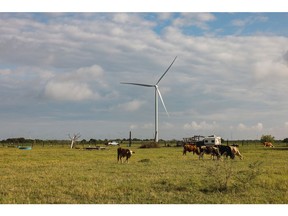Russia’s war in Ukraine, inflation and soaring power prices have cooled procurement. There’s one giant exception: Amazon.

Article content
(Bloomberg) —
Advertisement 2
Article content
Major corporations have made a one-way bet on renewable power: more of it, every year.
Article content
In 2012, companies procured power from 300 megawatts of wind and solar; last year, they bought more than 30 gigawatts’ worth, a 100-fold increase. There are now more than 125 gigawatts of clean power under contract to large companies around the world.
But look closely at data from the first half of 2022, and the one-way bet appears to be off. Corporate procurement of clean energy stopped short of 15 gigawatts, less than half of last year’s total. That means at the current pace 2022 could be the first down year in more than a decade for new corporate procurement of clean energy.
The relative decline is not evenly distributed. In the Americas, contracts are running only a few hundred megawatts behind 2021’s annualized rate. In the Asia Pacific region, though, contracts are running more than 20% ahead of pace. The bulk of the decline comes from paltry contract volumes in Europe, the Middle East and Africa. (Note that almost all contracts in this big region are in Europe proper.)
Advertisement 3
Article content
A number of factors are impairing the corporate clean energy market in Europe in particular. There’s the geopolitical uncertainty of Russia’s war in Ukraine, as well as the war’s impact on power prices (which have spiked to astronomical levels in France and Germany). Spiking prices and economy-wide inflation have made it very difficult to negotiate long-term power purchase terms.
There are a some bright spots: Spain’s and Denmark’s corporate clean energy markets are both on record pace. But the European market as a whole is constrained.
But the market in the Americas is not all that top-line figures would suggest. Amazon.com Inc. played an enormous role in overall corporate clean power purchasing, signing 25 contracts for 5 gigawatts of capacity on its own. Without that, volumes in the region would be well below last year’s trend as well.
Advertisement 4
Article content
Between 2020 and 2021, Amazon’s electricity consumption rose by nearly 29%. The company has purchased 19 gigawatts’ worth of clean power to date. That’s double the next largest corporate purchaser (Microsoft Corp., with 9 gigawatts). The clean power that Amazon now commands would make it the world’s 10th largest wind and solar portfolio.
The comparison isn’t exactly apples to apples because utilities own their assets, while Amazon just signs contracts for power. But it’s instructive. While Chinese companies dominate global clean power portfolios, Amazon uses more clean power than Warren Buffett’s Berkshire Hathaway Inc. owns, and more than French power giant Electricite de France SA (EDF). Amazon’s clean power is only slightly smaller than Europe’s two other major utility owners of renewable assets, Iberdrola SA of Spain and Enel SpA of Italy.
Advertisement 5
Article content
Amazon’s appetite is a sign of what’s ahead. Corporate demand for clean energy is growing, regardless of near-term market disruptions. Companies that have signed the RE100 pledge for 100% clean energy will require another 275 terawatt-hours worth of clean power in 2030, as much as Spain generates today.
Bonus Chart: California’s Power High
California set an all-time power demand record this week thanks to record heat in many parts of the state. The last record dates to 2006, and since then the state has added multiple gigawatts of rooftop solar . Something else wholly new since the last demand record: batteries.
The following chart shows five years’ worth of Labor Day grid-scale battery energy. It’s not hard to see the growth, and also not hard to imagine how much more strained California’s electricity grid would be without distributed solar generation and very large batteries discharging when the system needs them most.
Nat Bullard is a senior contributor to BloombergNEF and Bloomberg Green. He is a venture partner at Voyager, an early-stage climate technology investor.
Advertisement
For all the latest Business News Click Here
For the latest news and updates, follow us on Google News.

